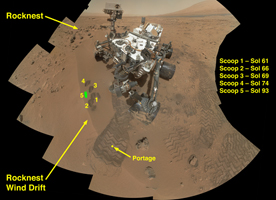
Annotated Image
Click on the image for larger versionNASA's Curiosity Mars rover documented itself in the context of its work site, an area called "Rocknest Wind Drift," on the 84th Martian day, or sol, of its mission (Oct. 31, 2012). The rover worked at this location from Sol 56 (Oct. 2, 2012) to Sol 100 (Nov. 16, 2012).
The drift consists of sand trapped on the downwind side of a group of dark cobbles the team named Rocknest. This mosaic of 55 images from the Mars Hand Lens Imager (MAHLI) shows the first four of five places from which the rover's scoop obtained sand to clean the sample handling and processing system. The scooped material was ultimately delivered to the Chemistry and Mineralogy Experiment (CheMin) and the Sample Analysis at Mars (SAM) laboratory instruments housed inside the rover's body. The annotated version of this figure shows the location of a scoop taken at a later date -- the fifth and final scoop, and the only one that provided grains delivered to SAM.
Before scooping, the rover team put an approximately 20-inch-wide (about 50- centimeter-wide) wheel print on the Rocknest wind drift. This allowed MAHLI and the Alpha Particle X-Ray Spectrometer (APXS) to determine whether the drift really consisted of sand with small enough sizes to clean the Collection and Handling for In-Situ Martian Rock Analysis (CHIMRA) instrument and be delivered to CheMin and SAM. The drift material at the center of the wheel print, named "Portage" by the rover team, was examined by the APXS.
The rover's robotic arm is not visible in the mosaic because the MAHLI that took this mosaic is on the turret at the end of the arm. Wrist motions and turret rotations on the arm allowed MAHLI to acquire the mosaic's 55 images. An earlier version of the Sol 84 self-portrait was released Nov. 1, 2012 (see PIA16239).
JPL manages the Mars Science Laboratory/Curiosity for NASA's Science Mission Directorate in Washington. The rover was designed, developed and assembled at JPL, a division of the California Institute of Technology in Pasadena.
For more about NASA's Curiosity mission, visit: http://www.jpl.nasa.gov/msl, http://www.nasa.gov/mars, and http://mars.jpl.nasa.gov/msl.

